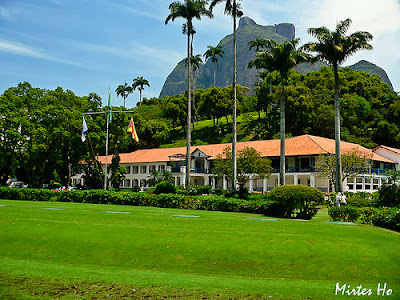São Conrado é um bairro da zona sul da cidade do Rio de Janeiro que apresenta grande desigualdade entre sua população. Junto à praia e em parte das encostas de montanhas da Floresta da Tijuca se constiui num bairro de classe alta, com mansões e condomínios de luxo. Na encosta da montanha que vai dar no bairro da Gávea, está localizada a maior favela da América do Sul, a favela da Rocinha, habitada por uma população de baixa renda.
Seu nome deriva do nome da igreja construída em 1903 pelo comendador Conrado Jacob Niemeyer, dono das terras que formariam o futuro bairro, chamada de Igreja de São Conrado.
Através do loteamento das propriedades de Conrado Niemeyer, surgiu um novo bairro que emancipou-se do bairro da Gávea.
O bairro conta com um shopping, o São Conrado Fashion Mall, e o Gávea Golf Country Clube voltados para o lazer da classe alta. Conta também com 2 hotéis de luxo.
Seus imóveis já tiveram um dos metros quadrados mais caros da cidade, mas acabaram se desvalorizando em função da violência, do tráfico de drogas e à própria proximidade com a favela da Rocinha.
O cartão-postal do bairro é a Pedra da Gávea, o maior bloco de pedra à beira-mar do Brasil. Da rampa junto à Pedra Bonita, os praticantes de voo livre saltam de asa-delta e de parapente, pousando no trecho final da Praia de São Conrado, conhecido como Praia do Pepino.
São Conrado é cortado pela Autoestrada Lagoa-Barra, principal eixo de ligação entre a Zona Sul e a Barra da Tijuca. Outras antigas vias passam pelo bairro, como a Avenida Niemeyer (ligação com o bairro do Leblon), a Estrada do Joá (ligação com a Barra da Tijuca) e a Estrada das Canoas, que sobe a montanha em direção ao bairro do Alto da Boa Vista.
São Conrado
São Conrado is a neighborhood in the southern part of the city of Rio de Janeiro which features great inequality among its population. Next to the beach and partly on the slopes of mountains of Tijuca forest, your population consists of people with high income, living in mansions and luxury condos. On the slope of the mountain (which will take in the neighborhood of Gávea), is located the largest favela in South America, the favela of Rocinha, inhabited by a population of low income.
Its name derives from the name of the Church was built in 1903 by the Commendatore Conrado Jacob Niemeyer, owner of the land that would form the future neighborhood, called the Church of São Conrado.
Through the allotment of Conrado Niemeyer properties, emerged a new neighborhood that became the neighborhood of Gávea.
The district has a mall, the São Conrado Fashion Mall, and the Gávea Golf Country Club for the recreation of the upper class. It also features 2 luxury hotels.
Their properties have already had one of the most expensive square meter of the city, but ended up devaluing due to violence, drug trafficking and the proximity to the favela of Rocinha.
The postcard of the neighborhood is the Pedra da Gávea, the largest block of beachfront stone from Brazil. The ramp in the Pedra Bonita, for practitioners of free flight jump of hang gliding and paragliding, landing in the final stretch of the São Conrado beach, known as Pepino beach.
São Conrado is cut by Highway Lagoa-Barra, main shaft connecting the South zone and Barra da Tijuca. Other ancient routes pass through the neighbourhood, as Niemeyer Avenue (linking with the neighborhood of Leblon), Joa road (linking with the Barra da Tijuca) and Estrada das Canoas, that climbs the mountain toward the neighborhood of Alto da Boa Vista.
Praia do Pepino
Favela da Rocinha
Pedra da Gávea e Pedra Bonita
Vôo livre
Gávea Golfe Country Clube
São Conrado Fashion Mall
Morro Dois Irmãos ao fundo visto do Elevado do Joá






























Nenhum comentário:
Postar um comentário